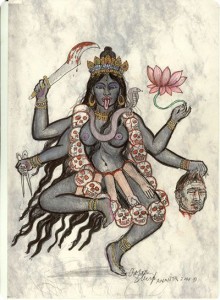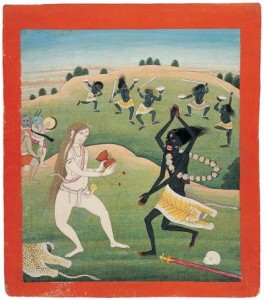
Kali is the Hindu goddess associated with death. Kali means dark mother or black one, which is suiting because she is one of the fiercest forms of mother Shakti.
Lord Shiva is called Kala—the eternal time—therefore Kali, his consort, is the Goddess of time and change. In many sources Kali is praised as the highest reality or greatest of all deities.
Kali is the fierce aspect of the goddess Durga (Parvati). It is said that Durga gives the strength to begin and support the process of change, but Kali has the powerful force to annihilate and remove old structures.
Symbolism of Kali
Kali’s fierce form is strewed with symbols. Her dark colours stand for the ultimate void state, where all differences dissolve into the absolute beyond all form, our transcendental nature.
Just as all colors disappear in black, so all names and forms disappear in her.
– Mahanirvana Tantra
Her nudity is primeval, fundamental, and transparent like Nature—the earth, sea, and sky. Kali is free from the illusory covering, for she is beyond the all maya or “false consciousness.” Her garland of fifty human heads that stands for the fifty letters in the Sanskrit alphabet, symbolizes infinite knowledge.
Kali is often depicted standing on Lord Shiva’s dead body. Her position on top of Shiva reveals that she is the dynamic force in the universe, the power that churns the stillness of the void, so worlds can be created inside that transcendent nothingness.
The Cremation Grounds
O Kali, Thou art fond of cremation grounds;
so I have turned my heart into one
That thou, a resident of cremation grounds,
may dance there unceasingly.
O Mother! I have no other fond desire in my heart;
fire of a funeral pyre is burning there;
O Mother! I have preserved the ashes of dead bodies all around
that Thou may come.
O Mother! Keeping Shiva, conqueror of Death, under Thy feet,
Come, dancing to the tune of music;
Prasada waits With his eyes closed– Ramprasad (1718-75)
Kali is often found in the cremation grounds, a place where the five elements are dissolved. She dwells where dissolution takes place. In terms of devotion and worship, this denotes the dissolving of attachments, anger, lust, and other binding emotions, feelings, and ideas. It is actually in the Heart of the devotee where this burning takes place, and it is in the Heart that Kali dwells. The devotee visualizes Kali in his Heart and under her influence burns away all limitations and ignorance in the cremation fires. This inner cremation fire in the Heart is the fire of knowledge, which Kali bestows. Ultimately, Kali offers us the freedom that lies beyond death.
She knows that your greatest self can only rise from the ashes of the lesser you.
The Destroyer (Change)
Most people choose to avoid endings because it is often associated with pain. Unfortunately, when we choose to avoid endings, we leave no space in our lives for new beginnings. One of Kali’s teachings is that in order for something new to be born, old structures must first be destroyed. Her name, Kali, is the feminine form of Kala, of Time, the great destroyer of even those things that seem permanent. In order to live a full life, we must begin again and again, allowing the perfect cycle of death and rebirth to continue, moment to moment.
Every moment, if you look with awareness, a new instance begins. This will only be part of your direct experience if you are aware of the space in-between all things: sounds, words, actions—you will see that one instance dies and a new instance arises in each and every moment. Although this may seem like a far reach from daily experience, it does occur to most to us during the more grand moments of life when: someone dies, a relationship ends, the loss of a job, the death of old-thought habits. The ancient yogis, were said to have been able to create, sustain, and then destroy the entire universe, in the blink of an eye. Something new emerged for them, in every single blink. Wow, what an ability to change, to adapt to any life situation that may arise— what an amazing way to live life.
Kali destroys the “moments” of each experience to make way for new experiences. She is worshipped because there is something beautiful in destruction, in death. It gives rise to something new. It allows us to change, to transform. When Kali is at work, you can trust her to show you what is truly indestructible. She does this by dissolving everything in you except that which cannot be destroyed, consciousness. That’s why we need her. Without her ruthless insistence on melting us to the core, we’ll never get down to our essence, down to the apparent nothingness that alone can reveal our true vastness, and our of which real creation arises. However, to know her gifts, you must, in some way, surrender to her intensity. As she sweeps away layers of ego, the depth of her loving care is revealed. For this reason, Kali is the ultimate teacher.
Tantric worshippers of Kali thought it essential to face her Curse, the terror of death, as willingly as they accepted Blessings from her beautiful, nurturing, maternal aspect.
For them, wisdom meant learning that no coin has only one side: as death can’t exist without life, so also life can’t exist without death.
– The Encyclopedia of Myths, Barbara Walker
Kali does indeed dissolve our structures, but it’s always in service of the Heart. She reverses the process of manifestation (see Tattvas) that brings form out of the formless and takes us back to the absolute. In meditation, Kali is the power that can turn the mind inward, dissolving our sense of the body, dissolving our thoughts, liberating emotions into energy, and drawing all our energies into their source in the inner Heart. Her great dissolve carries us into the recognition that all things are one in the Self. In the heart of hearts, Kali lives as the magnetic draw of ultimate oneness, the call of the Self to let go of everything that would separate us from what we always already are.
Mythological Stories
The Dance with Shiva
 Many stories describe Kali’s dance with Shiva as one that “threatens to destroy the world” by its ferocious power. The image of Kali dancing with Shiva follows closely the myth, from the Shiva Purana, of the demon Daruka, who could only be defeated by a woman. When Shiva asks his wife Parvati to destroy this demon, she enters Shiva’s body and transforms herself from the poison that is stored in his throat. In this way, she takes all the negativity of the collective consciousness, which she turns into wrath. She emerges from Shiva as Kali, ferocious in appearance, and with the help of her flesh eating entourage attacks and defeats the demon. Kali however became so intoxicated by the blood lust of battle that her aroused fury and wild hunger threatened to destroy the whole world. She continued her ferocious rampage until Shiva manifested himself as an infant and lay crying in the midst of the corpse-strewn field. Kali, deceived by Shiva’s power of illusion, became calm as she suckled the baby. When evening approached, Shiva performed the dance of creation (tandava) to please the goddess. Delighted with the dance, Kali and her entourage joined in.
Many stories describe Kali’s dance with Shiva as one that “threatens to destroy the world” by its ferocious power. The image of Kali dancing with Shiva follows closely the myth, from the Shiva Purana, of the demon Daruka, who could only be defeated by a woman. When Shiva asks his wife Parvati to destroy this demon, she enters Shiva’s body and transforms herself from the poison that is stored in his throat. In this way, she takes all the negativity of the collective consciousness, which she turns into wrath. She emerges from Shiva as Kali, ferocious in appearance, and with the help of her flesh eating entourage attacks and defeats the demon. Kali however became so intoxicated by the blood lust of battle that her aroused fury and wild hunger threatened to destroy the whole world. She continued her ferocious rampage until Shiva manifested himself as an infant and lay crying in the midst of the corpse-strewn field. Kali, deceived by Shiva’s power of illusion, became calm as she suckled the baby. When evening approached, Shiva performed the dance of creation (tandava) to please the goddess. Delighted with the dance, Kali and her entourage joined in.
Behold my Mother playing with Shiva,
lost in an ecstasy of joy!
Drunk with a draught of celestial wine,
She reels, and yet does not fall.
Erect She stands on Shiva’s bosom,
and the earth Trembles under Her tread;
She and Her Lord are mad with frenzy,
casting Aside all fear and shame.– Ramprasad (1718-75)
Sati’s Fearsome Form
Sati (Shiva’s first wife) is invited by her father, Daksha, to a fire ritual ceremony. Daksha doesn’t approve of her marriage to Shiva, so he does not invite Shiva. Not wanting to miss the event, Sati asks Shiva for permission to go without him. Shiva refuses.
Furious, Sati takes on her fearsome form as Kali. Shiva is terrified of her and tries to flee. But Kali fills all of space with her innumerable forms of herself until Shiva finally surrenders, sits down before her, and asks, “Where is my beautiful Sati?” She answers that this is her real form, and that she has taken on the sweet body of Sati to reward Shiva for his austerities. It is in her fearsome form, she tells Shiva, that she carries out the divine functions of creation and destruction.